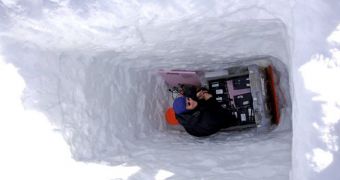According to a new scientific paper, published in the latest issue of the respected scientific journal Geology, it would appear that glaciers can experience the effects of so-called “icequakes” several hundreds of times each day. The events, which shake ice caps to their very core, can send out shock waves similar to the ones earthquakes generate when two tectonic plates release the tension they accumulated for centuries or millennia. These vibrations ices are experiencing could provide researchers with a new tool to better understand the effects of global warming and climate change.
“A huge number of pops and creaks are occurring all of the time in glaciers. Something as simple as a warm afternoon or a rainstorm has a direct and almost immediate influence on a glacier that can be tracked by listening to the creaks and groans that the ice makes,” reveals University of Alaska in Fairbanks seismologist and researcher Michael West. He explains that, in the particular case of ices in Antarctica, the force of the ensuing seismic waves can be equaled to that generated by a magnitude 7 earthquake occurring on land.
“I compare [these events] to a bear groaning as it emerges from hibernation in the spring. These results give us a time frame for how long it takes the glacier to come back to life after a relative winter repose. More importantly however, it provides an example of how the same techniques could be used over several years to map long-term changes,” he adds, quoted by LiveScience. It is conceivable that, in the near future, researchers could develop a set of statistical tools that would allow for computer models to take into account the number and intensity of icequakes, especially in producing long-term forecasts of how ice will melt in a particular region.
But collecting the large datasets required for computer models may prove to be trickier than gathering info via earthquakes. “The primary challenge is that glaciers are extremely challenging places to install equipment. While the highest resolution data probably comes from instruments installed directly in the ice, we may have to carry out long-term observations using instruments installed on the bedrock adjacent to glaciers. It is doubtful that in-ice installations will ever be able to run consistently for many years. Since glaciers flow, the stations are always moving!” West concludes.

 14 DAY TRIAL //
14 DAY TRIAL //